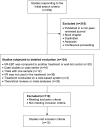Virtual reality exposure-based therapy for the treatment of post-traumatic stress disorder: a review of its efficacy, the adequacy of the treatment protocol, and its acceptability
- PMID: 26491332
- PMCID: PMC4599639
- DOI: 10.2147/NDT.S89542
Virtual reality exposure-based therapy for the treatment of post-traumatic stress disorder: a review of its efficacy, the adequacy of the treatment protocol, and its acceptability
Abstract
Introduction: The essential feature of post-traumatic stress disorder (PTSD) is the development of characteristic symptoms following exposure to one or more traumatic events. According to evidence-based intervention guidelines and empirical evidence, one of the most extensively researched and validated treatments for PTSD is prolonged exposure to traumatic events; however, exposure therapy can present some limitations. Virtual reality (VR) can help to improve prolonged exposure because it creates fictitious, safe, and controllable situations that can enhance emotional engagement and acceptance.
Objective: In addition to carrying out a review to evaluate the efficacy of VR exposure-based therapy (VR-EBT) for the treatment of PTSD, the aim of this study was to contribute to analyzing the use of VR-EBT by: first, evaluating the adequacy of psychological treatment protocols that use VR-EBT to treat PTSD; and second, analyzing the acceptability of VR-EBT.
Method: We performed a replica search with descriptors and databases used in two previous reviews and updated to April 2015. Next, we carried out an evaluation of the efficacy, adequacy, and acceptability of VR-EBT protocols.
Results: Results showed that VR-EBT was effective in the treatment of PTSD. The findings related to adequacy showed that not all studies using VR-EBT reported having followed the clinical guidelines for evidence-based interventions in the treatment of PTSD. Regarding acceptability, few studies evaluated this subject. However, the findings are very promising, and patients reported high acceptability and satisfaction with the inclusion of VR in the treatment of PTSD.
Conclusion: The main weaknesses identified in this review focus on the need for more controlled studies, the need to standardize treatment protocols using VR-EBT, and the need to include assessments of acceptability and related variables. Finally, this paper highlights some directions and future perspectives for using VR-EBT in PTSD treatment.
Keywords: evidence-based intervention; prolonged exposure; treatment efficacy.
Figures
References
-
- American Psychiatric Asociation . Diagnostic and statistical manual of mental disorders (DSM-5) 5 ed. Arlington, VA: American Psychiatric Asociation; 2013.
-
- Chambless DL, Baker MJ, Baucom DH, Beutler LE, Calhoum KS, Crits-Christoph P. Update on empirically validated therapies, II. The Clinical Psychologist. 1998;51:3–16.
-
- Rapaport MH, Clary C, Fayyad R, Endicott J. Quality-of-life impairment in depressive and anxiety disorders. American Journal of Psychiatry. 2005;162(6):1171–1178. - PubMed
-
- National Institute for Clinical Excellence . Post-traumatic stress disorder (PTSD): The management of PTSD in adults and children in primary and secondary care (clinical guideline 26) London, UK: National Institute for Clinical Excellence; 2005.
Publication types
LinkOut - more resources
Full Text Sources
Medical
Miscellaneous


